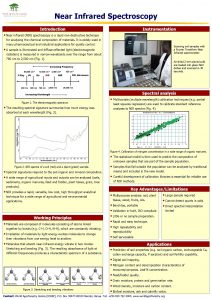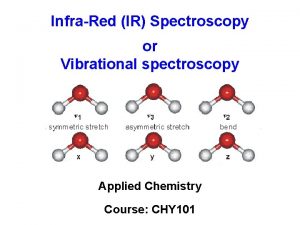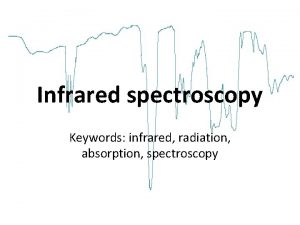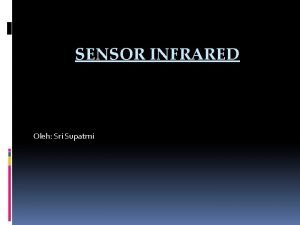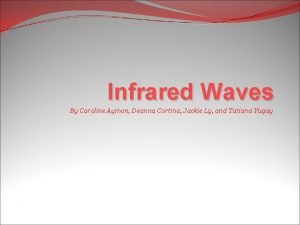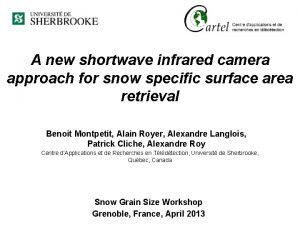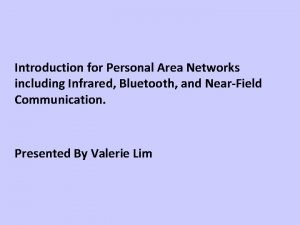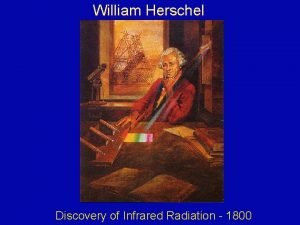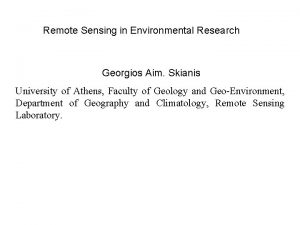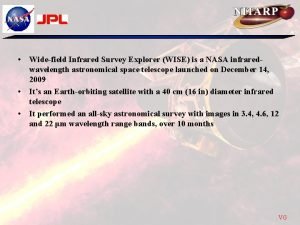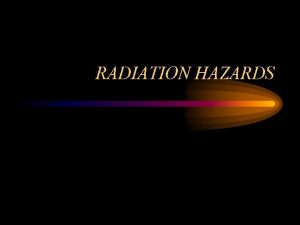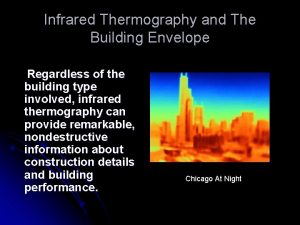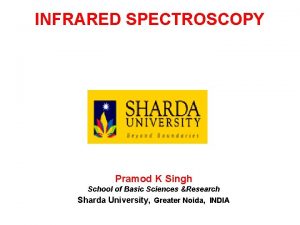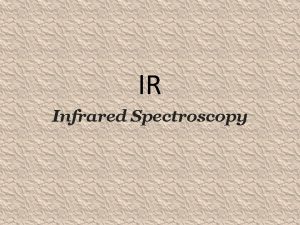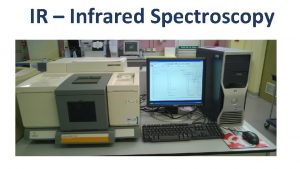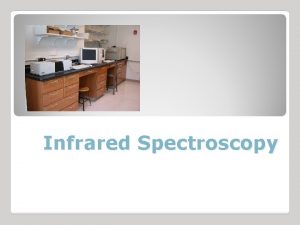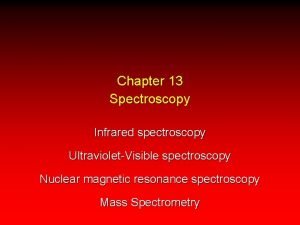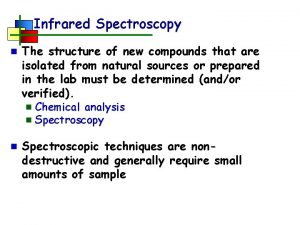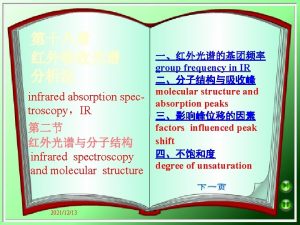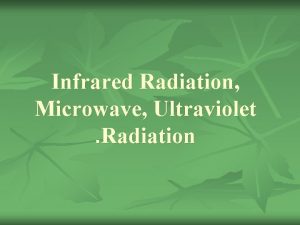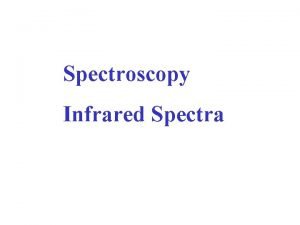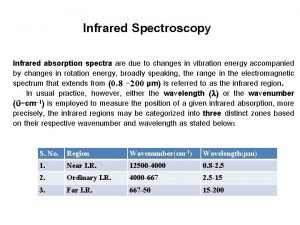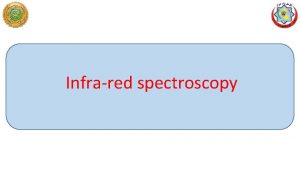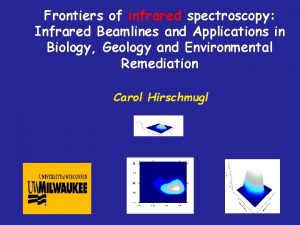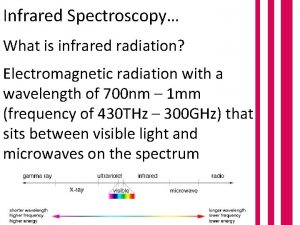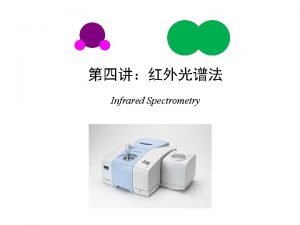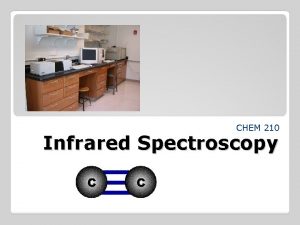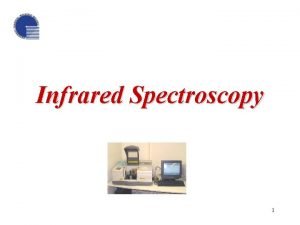Infrared Spectroscopy n The structure of new compounds































- Slides: 31

Infrared Spectroscopy n The structure of new compounds that are isolated from natural sources or prepared in the lab must be determined (and/or verified). n n n Chemical analysis Spectroscopy Spectroscopic techniques are nondestructive and generally require small amounts of sample

Infrared Spectroscopy n Four common spectroscopic techniques used to determine structure: Infrared Spectroscopy (IR) Mass Spectrometry (MS or Mass Spec) Nuclear Magnetic Resonance Spectroscopy (NMR) n Ultraviolet Spectroscopy n n n

Infrared Spectroscopy n Infrared spectroscopy: n Used to determine the functional groups present (or absent) in a molecule http: //riodb 01. ibase. aist. go. jp/sdbs/ (National Institute of Advanced Industrial Science and Technology, 1/5/11)

Infrared Spectroscopy n Infrared spectroscopy is a type of absorption spectroscopy: n Any technique that measures the amount of light absorbed by (or transmitted through) a compound as a function of the wavelength of light n Sample is irradiated by a light source n Amount of light transmitted (or absorbed) at various wavelengths is measured by a detector n. A spectrum is obtained. n Graph of light transmitted (or absorbed) as a function of wavelength

Infrared Spectroscopy n Infrared spectroscopy uses light from the infrared region of the electromagnetic spectrum. n The absorption of IR radiation leads to absorption bands in the IR spectrum. The position of a band is reported in wavenumbers ( u ) n the number of wavelengths per cm n u = 10, 000 where l = mm l n Directly proportional to energy n

Infrared Spectroscopy n The atoms in a molecule are in constant motion. n The covalent bond between two atoms acts like a spring, allowing the atoms to vibrate (stretch and bend) relative to each other.

Infrared Spectroscopy n The absorption of IR radiation increases the amplitude of the various types of bond vibrations. n Stretching n Symmetric n Asymmetric n Bending

Infrared Spectroscopy n Since energy is quantized, covalent bonds can vibrate/stretch only at certain allowed frequencies. n The position of an absorption band correlates with the type of chemical bond.

Infrared Spectroscopy n The frequency of an absorption band in an IR spectrum depends primarily on: n Type of vibration n Stretching vibrations: higher frequency n Bending vibrations: lower frequency n Masses of the atoms in a bond n Strength of the bond order

Infrared Spectroscopy n The polarity of a bond has a significant impact on the intensity of an IR absorption band. n Vibrations that cause a significant change in the dipole moment of a chemical bond lead to strong absorption bands. n Vibrations that result in no change/very little change in dipole moment lead to very weak or no absorption band. n Symmetrical bonds often exhibit very weak or no absorption band.

Infrared Spectroscopy n Each molecule has a unique IR spectrum. n The IR spectrum is a “fingerprint” for the molecule. n IR spectrum results from a combination of all possible stretching and/or bending vibrations of the individual bonds and the whole molecule. n Simple stretching: ~1600 -4000 cm-1. n Complex vibrations: 600 -1400 cm-1, called the “fingerprint region. ”

Infrared Spectroscopy n IR Spectrum of n-octane

Infrared Spectroscopy n An IR spectrum is used to identify functional groups that are present (or absent). n n Cannot conclusively identify a structure by IR alone unless an IR spectrum of an authentic (known) sample of the compound is available. Absorptions from specific functional groups are found in certain regions of the IR spectrum.

Carbon-Carbon Bonds n Increasing bond order leads to higher frequencies: n C-C 1200 cm-1 (fingerprint region) n C=C 1600 - 1680 cm-1 n C C 2200 cm-1 (weak or absent if internal) n Conjugation lowers the frequency: n isolated C=C 1640 -1680 cm-1 n conjugated C=C 1620 -1640 cm-1 n aromatic C=C approx. 1600 cm-1 n C=C peaks are generally weak to moderate in intensity.

Carbon-Hydrogen Bonds with more s character absorb at a higher frequency. n sp 3 (alkane) C-H n just below 3000 cm-1 (to the right) n sp 2 (alkene or aromatic hydrocarbon) C-H n just above 3000 cm-1 (to the left) n sp (alkyne) C-H n at 3300 cm-1



O-H and N-H Bonds n Both O-H and N-H stretches appear around 3300 cm-1, but they look different. Alcohol O-H n broad with rounded tip when hydrogen bonding is present (sharp in the absence of hydrogen bonding) n Secondary amine (R 2 NH) n Broad (usually) with one sharp spike n Primary amine (RNH 2) n Broad (usually) with two sharp spikes. n No signal for a tertiary amine (R 3 N) n


NH Bend n A broad, round peak may be observed around 1600 cm-1 for the N – H bend, especially with primary amines. NH 2 stretch N-H bend has a different shape than an aromatic ring or C=C N-H bend

Carbonyls n Carbonyl stretches are generally strong: n n n Aldehyde Ketone Carboxylic acid Ester Amide ~1710 cm-1 ~1730 - 1740 cm-1 ~1640 -1680 cm-1 n Conjugation shifts all carbonyls to lower frequencies. n Ring strain shifts carbonyls to higher frequencies.

Aldehydes

Carboxylic Acids

Ketones

Esters n C=O stretch at ~ 1730 -1740 cm-1 n C-O stretch at 1000 -1300 cm-1 (broad) and strong (Note: other functional groups may have peaks in the 1000 -1300 cm-1 region too!) 1743 1245

Amides n C=O stretch at 1640 -1680 cm-1 n N-H stretch (if 1 o or 2 o) around 3300 cm-1 double peak) (sometimes a

Nitriles n C N absorbs just above 2200 n The alkyne C C signal is much weaker and is just below 2200 cm-1 (med – strong)

IR Spectroscopy Example: Interpret the following IR spectrum by assigning each of the major peaks. Identify what functional group(s) are present. 3403 cm-1 1604 cm-1 http: //riodb 01. ibase. aist. go. jp/sdbs/ (National Institute of Advanced Industrial Science and Technology, 12/30/09)

IR Spectroscopy Example: Interpret the following IR spectrum by assigning each of the major peaks. Identify what functional group(s) are present. 2814 cm-1 2733 cm-1 1691 cm-1 1642 cm-1 http: //riodb 01. ibase. aist. go. jp/sdbs/ (National Institute of Advanced Industrial Science and Technology, 12/30/09)

Infrared Spectroscopy Example: Which one of the following compounds is the most reasonable structure for the IR spectrum shown below? 1721 http: //riodb 01. ibase. aist. go. jp/sdbs/ (National Institute of Advanced Industrial Science and Technology, 12/30/09)

Infrared Spectroscopy Example: Which of the following compounds is the most reasonable structure for the IR spectrum shown below? 1603 1689 http: //riodb 01. ibase. aist. go. jp/sdbs/ (National Institute of Advanced Industrial Science and Technology, 12/30/09)
 Nir spectroscopy instrumentation
Nir spectroscopy instrumentation Aniline ir
Aniline ir Infrared spectroscopy theory
Infrared spectroscopy theory Infrared spectroscopy ppt
Infrared spectroscopy ppt Infrared spectroscopy
Infrared spectroscopy Ionic compounds and covalent compounds venn diagram
Ionic compounds and covalent compounds venn diagram Infrared vs bluetooth
Infrared vs bluetooth Infrared vs bluetooth
Infrared vs bluetooth Pengertian infrared
Pengertian infrared Bill nye light energy
Bill nye light energy Characteristics of infrared
Characteristics of infrared Infrared spektroskopisi
Infrared spektroskopisi Signage posted at a handwashing station must include
Signage posted at a handwashing station must include Shortwave infrared camera
Shortwave infrared camera Bluetooth vs infrared
Bluetooth vs infrared Hybridboard
Hybridboard Infrared radiation discovery
Infrared radiation discovery Thermal infrared
Thermal infrared Ers-1
Ers-1 Advantage and disadvantage of touch screen
Advantage and disadvantage of touch screen Nirops
Nirops Wide field infrared survey explorer
Wide field infrared survey explorer Espectro eletromagnético
Espectro eletromagnético Infrared radiation hazards
Infrared radiation hazards Infrared sensor principle
Infrared sensor principle Infrared building envelope
Infrared building envelope Made up school
Made up school Catalytic heater oil and gas
Catalytic heater oil and gas Hình ảnh bộ gõ cơ thể búng tay
Hình ảnh bộ gõ cơ thể búng tay Slidetodoc
Slidetodoc Bổ thể
Bổ thể Tỉ lệ cơ thể trẻ em
Tỉ lệ cơ thể trẻ em
